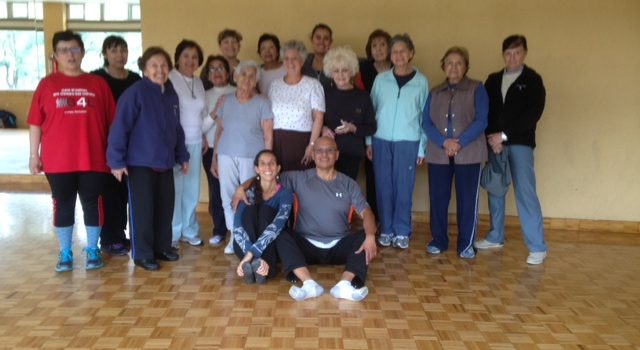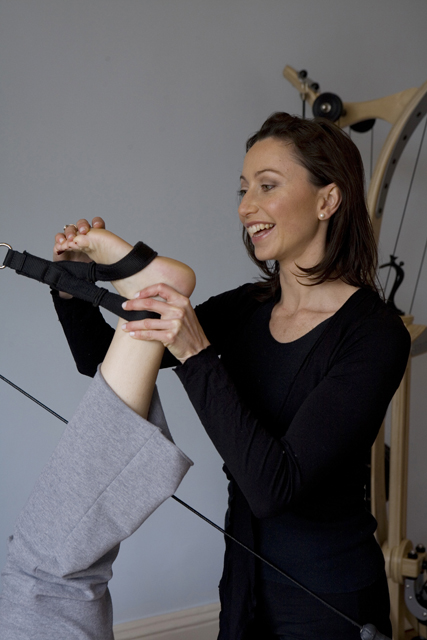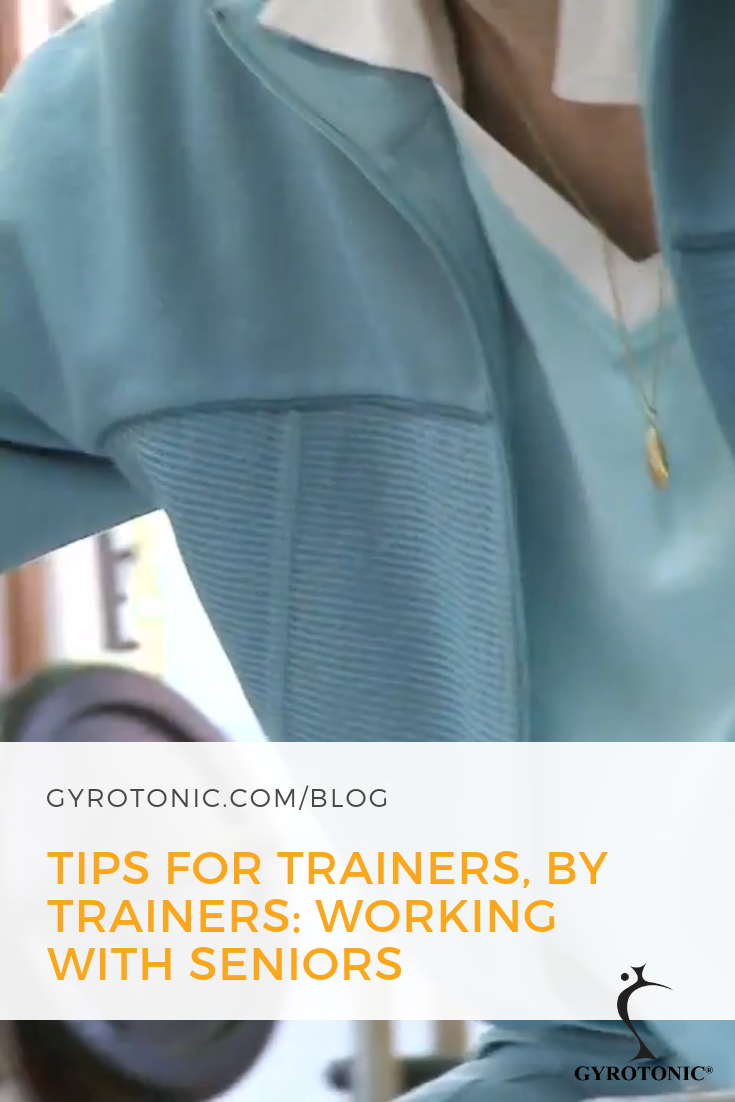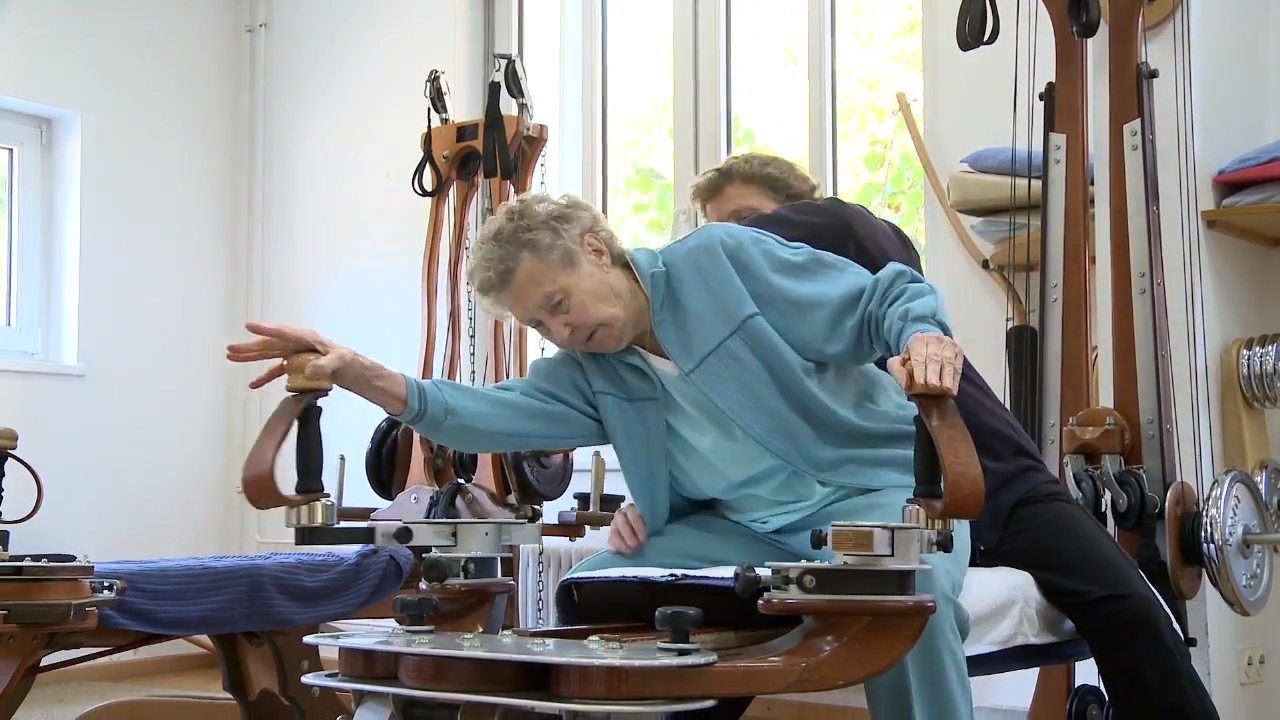We talked with some trainers in our community who shared how older adults can safely participate in well-designed and carefully supervised GYROKINESIS® and GYROTONIC® programs to maintain their health and boost their enthusiasm and energy.
Diane Israel – “Working With Our Elders”
GYROTONIC® and GYROKINESIS® Trainer
Boulder, Colorado
USA
Mariarosa Guglielmi
GYROTONIC® and GYROKINESIS® Master Trainer
Mexico City, Mexico
Seniors can safely participate in well designed and carefully supervised Gyrokinesis and Gyrotonic programs.
I recently had the pleasure to meet with and teach a Gyrokinesis class to a wonderful and special group of seniors (pictured below) in Mexico City.

Thanks to the years of dedication, love and support they have received from Gyrotonic and Gyrokinesis Trainer, Javier Duenas, during classes, I could sense how this had genuinely become a very integral and important part of their weekly routine.
I also saw how the Gyrokinesis Method has helped them maintain health, and boost their enthusiasm and energy, continually bringing them back to further their practice and learning.
They inspired me. I could feel their strong commitment to be in class and not miss. Their deep desire to feel good was fantastic!
Javier Duenas
GYROTONIC® and GYROKINESIS® Trainer
Mexico City, Mexico
For six years we have been teaching Gyrokinesis to seniors in Mexico City. Since the very first class, the experience for them has been extraordinary. They have felt freedom of action with their articulations and connected to the softness of the movements. The fluidity of the sequences has given them the sensation of life itself.
The first class we taught was with a group in an institution, especially designed for seniors. At first, we began with 20 participants. After six months the group increased to 45 participants!
The second experience was in a private sports club. The first classes were with approximately 20 participants. That class continues on still today.
In both groups there are a mix of abilities and needs, some with atrophies, others that claimed no physical impairments. However, both groups have enjoyed the classes. They advance class by class, gaining mobility and increasing range of motion.
The average age is about 75, but the most senior of our groups is 96! She is really happy with the classes because she is making incredible advancements with her bowel continence. She loves how she feels each time after the class.
Below are comments from some of our participants about what three years of Gyrokinesis classes has done for them:
- Helped increase muscle mass and the metabolic rate
- Reduced body fat, and helps bone mineral density
- Reduced blood pressure and improved glucose percentage in metabolism, making for faster gastrointestinal function
- Reduced arthritic pain as well as back pain.
- Experienced overall muscle and joint improvement
- Reduced corporal weight and depression, which is something invaluable for seniors
For us in México, the Gyrokinesis Method is an incredible method for working with seniors because they are able to work out muscle tension, stretch, increase range of motion, get aerobic activity, and experience rhythm and movement in all directions.
Regarding stamina, Gyrokinesis exercises are fantastic, because seniors can work out for one hour, continuously; in other circumstances, this might be very difficult. Really, for seniors, Gyrokinesis classes are a blessing.
Lisa Mathison Wood
GYROTONIC® Master Trainer and GYROKINESIS® Pre-Trainer
GYROTONIC® Sydney
Sydney, Australia
lisamathison@yahoo.com
www.gyrotonicsydney.com
I love to work with this age group. Age 65+ can be quite a broad group with probably the most varying degrees of abilities. The Gyrotonic and Gyrokinesis Methods are perfect exercises that offer the versatility to cater to all people. My purpose here is to help other Gyrotonic and Gyrokinesis Trainers navigate this territory.

For simplicity, I have categorized this age category into three groups, bearing in mind that there could be many sub-groups and unique pathologies within each group.
Group 1: Active / Fit
These people are doing some sort of physical exercise every day. They tend to have a positive outlook, lead an active and healthy lifestyle and consistently come to class.
Tips for Group 1: Active Fit
- Use all of the different Gyrotonic and Gyrokinesis standing sequences.
- Get them to set up the equipment as a part of their workout.
- Focus on alignment, refining, some Level 2 exercises, hip knee mobilization and getting the sequence of boney rhythm.
Group 2: Sedentary
These people are not as active, with general stiffness, mainly in the morning. They experience some pain, and discomfort intermittently. These clients may also be consistent coming to class. However, they are often more prone to bouts of illness that will take them out of action for short periods.
Tips for Group 2: Sedentary
- Use rhythm to build range of motion.
- Ease away the stiffness by starting small. Pulsation series on the handles is good for this, extending a little more with each repetition).
- Get them breathing, get them moving.
- Add only one point of attention at a time.
- For the kyphotic type, try the Gyrotonic arch and curl series with the client sitting on a stool (instead of the bench), facing the handles, with the handles at chest height. (This is if you do not have access to a GYROTONER®).
Group 3: Chronic pain
These people are in pain everyday. It is usually an effort to get to class. Usually there are multiple issues involved and life in general is less positive.
Tips for Group 3: Chronic Pain
- Ask them to feel in their body where they do not feel pain; or ask where they experience health. Keep their mind in that part of their body and with that sensation as you begin a session.
- Bring joy and lightness to the lesson.
- Acknowledge their achievement in coming to class.
- Use therapeutic exercises, starting supine; take time, breathe yawn, repeat.
- Teach them how to stand up, how to sit down, and how to apply the exercises to everyday activities.
- For spinal motions, face the pulley tower and attach the upper straps around the upper back to experience a relieving decompression.
Commonalities across all groups
These clients have had more time to feel the effects of gravity on the system. Compensatory patterns on a physical, mental and emotional level (if not previously addressed) have all had longer to set in. Spending longer periods sitting will have an obvious impact on the organs of the body. Metabolism is slowed, which contributes greatly to the loading passed on to other excretory organs.
Things to look out for:
- Dry skin, particularly on the hands and feet (due to hormonal changes and decrease in collagen)
- Ineffective breathing habits
- Tightness, particularly in the calves, neck, hip flexors and shoulders
- Pelvic floor weakening
- A slower neuromuscular response (coordination)
- Difficulties with balance
Tips for all groups
- Focus on the periphery first, as the hands and feet, being the furthest form the brain center, can be dry, cold and/or stiff.
- Teach the Gyrokinesis self-massage sequence; I encourage Groups 2 and 3 to do this for homework daily, as well as all the seated spinal motions. Ask the client to think about when might be the perfect time for them to do these exercises at home, so they visualize doing them on their own.
- Take longer preparing for the Gyrotonic hamstring sequence by opening the feet and calves, and include a kneading sequence.
- Do seated legwork facing the tower (may need back support). If you have access to the old balance body towers, the top bench could be taken off and turned around as a back support for this.
- Do the balancing, unwinding sequence; sideways stretches; Twist and Pull, from the Gyrotonic Upper Body Sequence; and shoulder mobilization exercises.
- Do something that challenges them and something within each client’s level of comfort.
- Demonstrate and move together with your client. As you embody the movement, they will follow.
In conclusion, remember to focus on health and, as with all other clients, meet them ‘where they are’. Keep in mind that they were once young and manage your own emotions and mindset around getting old (impatience / fear of sickness) so as not to project it onto them, or see them as ‘lesser’ clients.
Like your mumma always said, “Respect your elders” and listen; they might just have a real gem to share with you.”

Pin for later!

